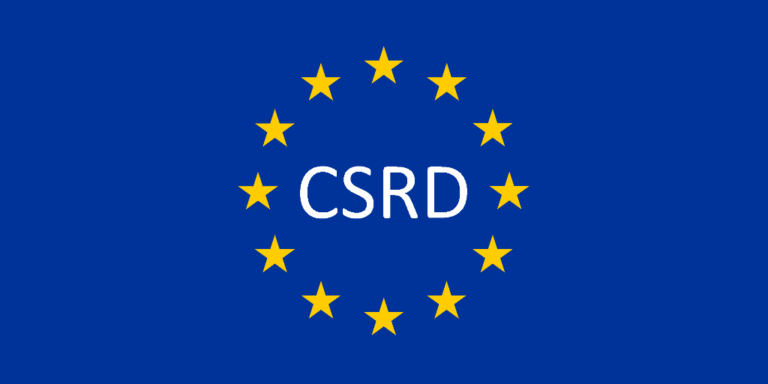As of the reporting year 2023, all large or listed companies within the EU will have to report according to the new CSRD (Corporate Sustainability Reporting Directive). This directive is a radical extension of the existing Non-Financial Reporting Directive (NFRD) and will play a key role in achieving the targets set out by the European Green Deal. What is the impact on your company? And what are the key differences with the current NFRD? For the answers to these questions, then keep reading.
We have talked about the CSRD in multiple blogs, you can find those here.
What is the new CSRD Corporate Sustainability Reporting Directive?
On 21 April 2021, the European Commission adopted a proposal for the Corporate Sustainability Reporting Directive (CSRD). Its main purpose is to increase the availability of sustainability information and to improve transparency for all stakeholders.
The CSRD is part of a larger strategy by the European Union to encourage the flow of finance towards sustainable investments. Alongside the EU Taxonomy and the Sustainable Finance Disclosure Regulation, the CSRD will enable investors who want to re-orient towards more sustainable businesses and technologies.
NFRD becomes CSRD
At the moment, the EU requires only a select group of large companies to disclose information on the way they operate and manage ESG challenges. By making this information publicly available, consumers, policymakers, investors, civil society, and other stakeholders get a better insight into the non-financial performance of these companies. This information allows them to make better-educated decisions.
These EU disclosure requirements were first introduced with the Non-Financial Reporting Directive (NFRD) in 2014. The requirements of the NFRD make it mandatory for large public-interest companies to publish information related to:
- Environmental matters
- Social matters and treatment of employees
- Respect for human rights
- Anti-corruption and bribery
- Diversity on company boards (in terms of age, gender, educational and professional background)
Currently, this covers approximately 11,700 companies in the EU.
The CSRD is an amendment to the existing NFRD requirements, which makes some crucial changes to the directive’s content.
Which sustainability topics does your company report on?
- Environmental matters (33%, 7 Votes)
- Social matters and treatment of employees (24%, 5 Votes)
- Diversity on company boards (19%, 4 Votes)
- Respect for human rights (14%, 3 Votes)
- Anti-corruption and bribery (10%, 2 Votes)
Total Voters: 7
The 4 key differences between NFRD and CSRD
The most significant differences between de current Non-Financial Reporting Directive (NFRD) and the new Corporate Sustainability Reporting Directive (CSRD) are:
1. The CSRD increases the number of companies required to disclose to 50,000
The new CSRD will cover all large companies and all listed companies. The CSRD classifies a large company as one that meets 2 out 3 of the following criteria:
- 250 full-time employees
- 40 million euro in turnover
- 20 million euro balance sheet total
This means that the number of companies required to disclose will increase from about 11,000 to an estimated 50,000.
2. The CSRD uses mandatory reporting standards
While guidelines for disclosure were published for the NFRD, they were not mandatory to use. This led to a wide variety of reporting methods between companies, making it hard to compare. For the CSRD, there will be mandatory EU reporting standards that all companies covered must use.
3. The CSRD requires external assurance
As opposed to the NFRD, information published for the CSRD will require external assurance. Initially, only limited assurance will be required, but it is not unthinkable that this will shift to reasonable assurance over time.
4. CSRD reports must be digitally tagged
And lastly, companies will be required to digitally tag the reported information to make it machine-readable. This is another way in which the proposal aims to facilitate easy comparison between companies.
Webinar CSRD and EU Taxonomy
With mandatory requirements, rapidly changing timelines, and a lack of clarity about when and what exactly needs to be reported, many companies are uncertain about how to prepare for the CSRD and EU Taxonomy. In this webinar on the 19th of May 2022, Valentijn dove into the latest developments and provides you with tips on how to best prepare for these mandatory disclosures.

Why is the CSRD introduced?
Since the initial introduction of the NFRD, the information need for ESG has increased exponentially among investors, consumers, and activists. Current sustainability reporting for companies covered by the NFRD is often severely lacking compared to the demands in the market.
Furthermore, for the companies that do report already, there is a lack of consistency and transparency in the data that gets reported. Since there are no mandatory guidelines under the NFRD, companies often resort to standards or frameworks that are easiest to implement. This can result in poor comparability between companies for external stakeholders.
What impact will the CSRD have on your company?
The CSRD will make it mandatory for an estimated 50,000 companies to report on their ESG performance, following the new EU guidelines. If you were not previously covered by the NFRD but are considered large, you will have to start thinking about your ESG reporting process and how to be best prepared.
Even if you are already reporting in accordance with the NFRD, the CSRD will also bring changes to your organization. The new mandatory guidelines and assurance requirements will bring a whole new challenge to your ESG reporting.
Timelines for the introduction of CSRD
The guidelines for the CSRD are expected towards the end of 2022, and they will then go into effect in 2023. This means that the first time companies must report following these new guidelines will be in early 2024, when the annual report for 2023 gets published. It is, therefore, crucial to know early what exactly needs to be measured to prevent unpleasant surprises later.
Will you have to report under the new CSRD, or are you not sure?
Reach out to us to discuss your situation and see how we can help you prepare for the CSRD.



